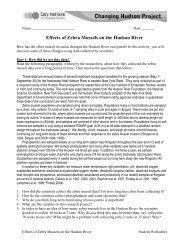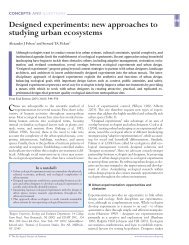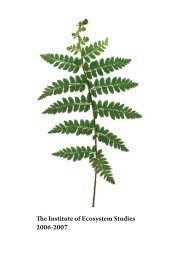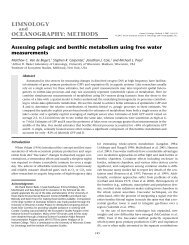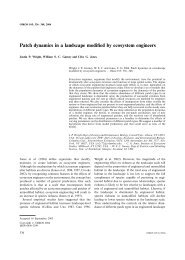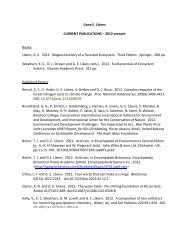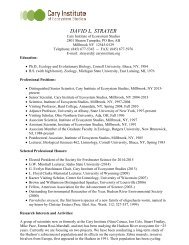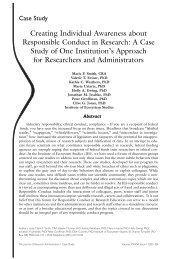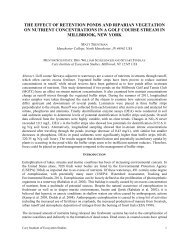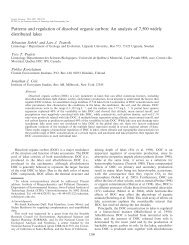Shell decay rates of native and alien freshwater bivalves and ...
Shell decay rates of native and alien freshwater bivalves and ...
Shell decay rates of native and alien freshwater bivalves and ...
You also want an ePaper? Increase the reach of your titles
YUMPU automatically turns print PDFs into web optimized ePapers that Google loves.
1614 D. L. Strayer <strong>and</strong> H. M. MalcomThree <strong>of</strong> the litter bags contained no shell materialwhen they were recovered, making it impossible forus to estimate k. Simply discarding data from thesebags would have biased our estimates <strong>of</strong> <strong>decay</strong> <strong>rates</strong>,so we estimated k by assuming that the amount <strong>of</strong>shell material remaining in these bags was half <strong>of</strong> theminimum remaining mass we observed for thatspecies at that site. We discarded data from onebag <strong>of</strong> Elliptio from the East Branch <strong>of</strong> WappingerCreek as an outlier because k for this bag was )0.50,whereas other bags from this site had k ¼ )0.03 to)0.06.-k (year –1 )<strong>Shell</strong> dry mass (g)Fig. 2 Decay <strong>rates</strong> <strong>of</strong> four different species <strong>of</strong> <strong>freshwater</strong> <strong>bivalves</strong>,averaged over all study sites except the Neversink River(at which no Sphaerium bags survived), as a function <strong>of</strong> meanshell mass <strong>of</strong> each species (r 2 ¼ 0.86, P < 0.04). Full speciesnames are given in Table 2.ResultsInstantaneous <strong>decay</strong> <strong>rates</strong> <strong>of</strong> bulk shell materialvaried enormously, ranging from )0.01 to 99%.Decay <strong>rates</strong> were significantly related to both <strong>bivalves</strong>pecies (two-way ANOVA, F ¼ 17.2, P < 0.0001) <strong>and</strong>site (F ¼ 12.9, P < 0.0001). Differences in <strong>decay</strong> <strong>rates</strong>among sites were correlated with both water movement<strong>and</strong> chemistry, <strong>and</strong> were much faster at siteswhere the water was both moving <strong>and</strong> s<strong>of</strong>t than atsites where the water was still or hard (whetherexpressed as Ca, DIC, or pH) (Fig. 1). Differences in<strong>decay</strong> <strong>rates</strong> across species were related to the size <strong>of</strong>the shell; small shells <strong>decay</strong>ed much more quicklythan large shells (Fig. 2). Loss <strong>rates</strong> <strong>of</strong> the inorganic<strong>and</strong> organic fractions <strong>of</strong> the shell were similar (Fig. 3),although as expected <strong>decay</strong> <strong>rates</strong> <strong>of</strong> organic matterrelative to those <strong>of</strong> CaCO 3 were a little higher in hardwaters than in s<strong>of</strong>t waters.DiscussionThe very wide range in shell <strong>decay</strong> <strong>rates</strong> that weobserved can be explained by water chemistry, watermovement <strong>and</strong> the size <strong>of</strong> the bivalve shell. If the fullrange <strong>of</strong> bivalve species [adult shell mass rangingfrom 1 kg DM (dry mass)/individual] <strong>and</strong>environmental conditions in fresh waters is considered(very s<strong>of</strong>t to supersaturated with CaCO 3 ), then<strong>rates</strong> <strong>of</strong> shell <strong>decay</strong> will vary even more than the 500-fold observed in our study. Ultimately it may be(a)(c)k (year –1 )(b)(d)Dissolved calcium (mg L –1 )Fig. 1 Mean <strong>decay</strong> <strong>rates</strong> (±1 SE) <strong>of</strong> fourspecies <strong>of</strong> <strong>freshwater</strong> <strong>bivalves</strong> across arange <strong>of</strong> sites in south-eastern New York,as a function <strong>of</strong> dissolved Ca in the water.Species are (a) Corbicula fluminea, (b) Dreissenapolymorpha, (c) Elliptio complanata<strong>and</strong> (d) Sphaerium striatinum. Note thelarge differences in scales on the Y-axes.Ó 2007 The Authors, Journal compilation Ó 2007 Blackwell Publishing Ltd, Freshwater Biology, 52, 1611–1617



